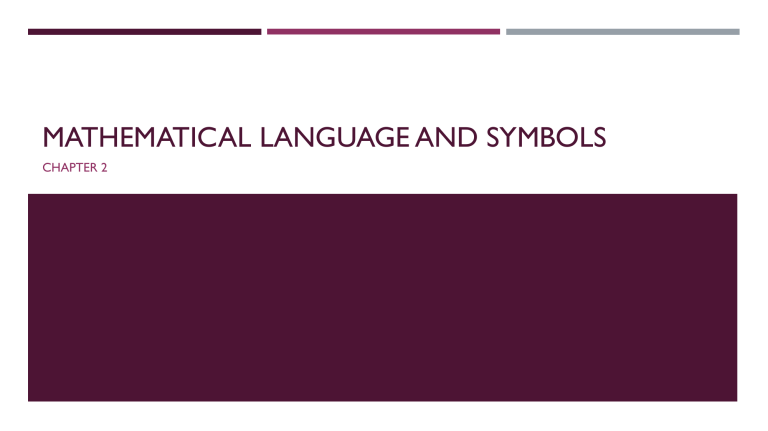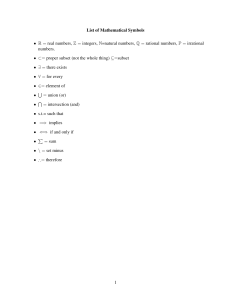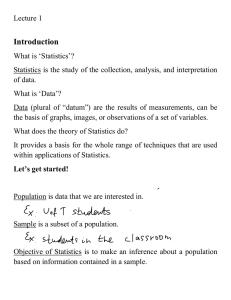
MATHEMATICAL LANGUAGE AND SYMBOLS
CHAPTER 2
THE LANGUAGE, SYMBOLS, SYNTAX AND RULES OF MATHEMATICS
The language of mathematics is the systematic used by mathematicians to communicate mathematical ideas
among themselves.
Mathematics as a language has symbols to express a formula or to represent a constant. It has syntax to make the
expression well-formed to make the characters and symbols clear and valid thar do not violate the rules.
Symbol
Meaning
Example
+
Add
3+7 = 10
-
Subtract
10-3 = 7
x
Multiply
5x6 = 30
÷
Divide
45 ÷5 = 9
/
Divide
45/5 = 9
π
Pi
𝐴 = 𝜋𝑟 2
∞
Infinity
∞ is endless
=
Equal
1+1 = 2
≈
Approximately
π ≈ 3.14
≠
Not equal to
3≠4
<≤
Less than, less than or equal to
2<3
>≥
Greater than, greater than or equal to
5>2
√
Square root
√4 = 2
°
Degrees
20°
Therefore
A=B
B=A
PERFORM OPERATIONS ON MATHEMATICAL EXPRESSION CORRECTLY
P
Parenthesis
E
Exponents
M
Multiplication
D
Division
A
Add
S
Subtraction
11 − 5
6
2
2
×2−3+1
×2−3+1
16 − 3 8 − 3
16 − 3 5
2
2
÷5
36 × 2 − 3 + 1
16 − 3(25) ÷ 5
72 − 3 + 1
16 − 75 ÷ 5
73 − 3
16 − 15
70
1
÷5
THE FOUR BASIC CONCEPTS OF MATHEMATICS
Set
A set is a collection of well-defined objects that
contains no duplicates.
The objects in the set are called elements of the
sets.
To describe a set, we use braces {} and use capital
letters to represent it.
Z = {1, 2, 3, …}
Relation
A relation is a rule that pairs each elements in one
set, called the domain, with one or more elements
from a second set called range.
It create sets of ordered pairs.
Holidays
Month and Date
New Year’s Day
January 1
Labor Day
May 1
Independence Day
June 12
Bonifacio Day
November 30
Rizal Day
December 30
SPECIFICATIONS OF SET
There are three main ways to specify a set:
1. List Notation/ Roster Method – by listing all its members
Examples: 1. {1, 12, 24}
2. {a, b, d, m}
2. Predicate Notation / Rule Method – by stating a property od its elements.
Examples: 1. {x|x is a natural number and x<8}
than 8”
means “the set of all x such that x is a natural number and is less
2. {y|y is a student of UC-Banilad and y is older than 25}
3. Recursive Rules – by defining a set of rules which generates or define its members.
Examples: 1. the set of E of even numbers greater than 3:
a. 4∈ E
b. if x ∈ E, then x+2 ∈ E
c. nothings else belongs to E
EQUAL SETS
Two sets are equal if they contain exactly the same elements
Examples:
1. {3, 8, 9} = {9, 8, 3}
2. {6, 7, 7, 7, 7} = {6, 7}
3. {1, 3, 5 , 7} ≠ {3, 5}
EQUIVALENT SETS
Two sets are equivalent if they contain the same number of elements.
Examples:
{1, 2, 3} , {a, b, c} , ∞, 𝜃, 1 , {
,
,
}
All of the given sets are equivalent.
***Note that no two of then are equal but they all have the same number of elements.
UNIVERSAL SET
A set that contains al elements considered in a particular situation and denoted by 𝑼.
Examples:
a. Suppose we list the digits only.
Then 𝑼 = {0, 1, 2, 3, 4, 5, 6, 7, 8, 9}
b. Suppose we consider the whole numbers
Then 𝑼 = {0, 1, 2, 3, 4, ….} since 𝑼 contains all numbers
SUBSETS
A set A is called a subset of set B if every element of A is also an element of B. “ A is a subset of B is
written as A⊆ 𝐁.
Examples:
1. A = {7, 9} is a subset of B = {6, 9, 7}
2. D = {10, 8, 6} is a subset of G = {10, 8, 6}
A⊆B
D⊆G
PROPER SUBSET AND IMPROPER SUBSET
Proper subset is a subset that is not equal to the original set, otherwise improper subset.
Examples:
Given: {3, 5, 7}
Proper subset: {}, {5, 7} , {3, 5} , {3,7}
Improper subset : {3, 5, 7}
CARDINALITY OF THE SET
It is the number of distinct elements belongings to a finite set. It is also called the cardinal number of the set A
denoted by 𝑛 A or card A and |A|.
OPERATIONS OF SETS
Union – is an operation of set A and B in which a set is formed that consists of all the elements
included A or B both denoted by ∪ as A ∪ B.
Examples:
𝑼 = {1, 2, 3, 4, 5, 6, 7, 8, 9}
A ={ 1, 3, 5, 7}
B = {2, 4, 6, 8}
C= {1, 2}
Find the following:
a. A ∪ B
b. A ∪ C
c. (A ∪ B) ∪ {8}
Solution:
a. A ∪ B = {1, 2, 3, 4, 5, 6, 7, 8}
b. A ∪ C = {1, 2, 3, 5, 7}
c. (B ∪ C) = {1, 2, 4, 6, 8}
OPERATIONS OF SETS
Intersection – It is the set containing all elements common to both A and D denoted by ∩.
Examples:
𝑼 = {a, b, c, d, e}
A ={ c, d, e}
B = {a, c, e}
C = {a}
D = {e}
Find the following:
a. B ∩ C
b. A ∩ C
c. (A ∩ B) ∩ D
Solution:
a. B ∩ C = {a}
b. A ∩ C = ∅
c. (A ∩ B) ∩ D = {c, e} ∩ {e}
= {e}
OPERATIONS OF SETS
Complementation – is an operation on a set that must be performed in reference to a universal set
denoted by 𝑨′ .
Examples:
𝑼 = {a, b, c, d, e}
A ={ c, d, e}
B = {a, c, e}
Find the following:
a. 𝐴′
b. 𝐵′
Solution:
a. 𝐴′ = {a, b}
b. 𝐵′ = {b, d}
THE FOUR BASIC CONCEPTS OF MATHEMATICS
Functions
It is a rule that pairs each elements in one set, called
domain (X) and range (Y).
This means that for each first coordinate, there is
exactly one second coordinate or for every first
elements of X, there corresponds a unique second
element Y
Binary
A binary operation on a set is a calculation involving
two elements of the set to produce another element
of the set.
A new math (binary) operation, using the symbol *,
is defined to be a*b = 3a+b, where a and b are real
numbers.
Examples:
What is 4*3?
4*3 = 3(4) +3
a= 4 b=3
12+ 3
15
ELEMENTARY LOGIC
According to David W. Kueker, logic is simply defined as the analysis of methods of reasoning. Mathematical Logic
is the study of reasoning as used in mathematics.
In ordinary mathematical English the use of “therefore” customarily indicates that the following statements is a
consequence of what comes before.
Examples:
1. All men are mortal. Luke is a man. Hence, Luke is mortal.
2. All dogs like fish. Cyber is a dog. Hence, Cyber likes fish.
LOGICAL OPERATORS / CONNECTIVES
Proposition (statement) is a sentence that is either true or false (without additional information) denoted by P
and Q
The logical connectives are defined by truth tables.
Connectives
Symbol
Words
Negation
~ or ¬P
Not / The opposite
Conjunction
p^q
And / Both are True
Disjunction
pvq
Or / One is true, then all is True
Implication
p
Bi-conditional
p
q
If, then / False if q is false and p is true/ True if q is true and
p is false
q
If and only if / True when p and q are both true or false.
TRUTH TABLE
p
q
¬p
Negation
¬q
p^q
pvq
p
q
Negation Conjunction Disjunction Implication
p
q
Biconditional
T
T
F
F
T
T
T
T
T
F
F
T
F
T
F
F
F
T
T
F
F
T
T
F
F
F
T
T
F
F
T
T
p
q
¬p
¬p v q
(¬p v q) ^ p
q
¬p
(¬p v q)
T
T
F
T
T
F
F
T
F
F
F
F
T
F
F
T
T
T
F
T
F
F
F
T
T
F
T
F
(q
¬p)




